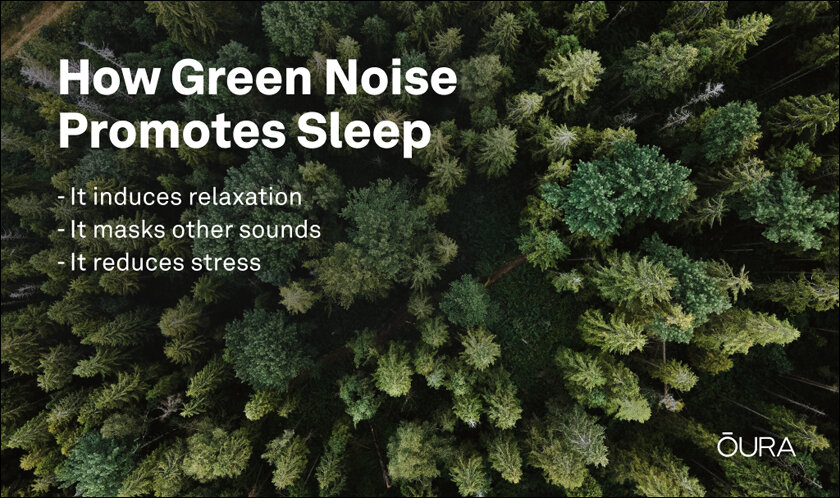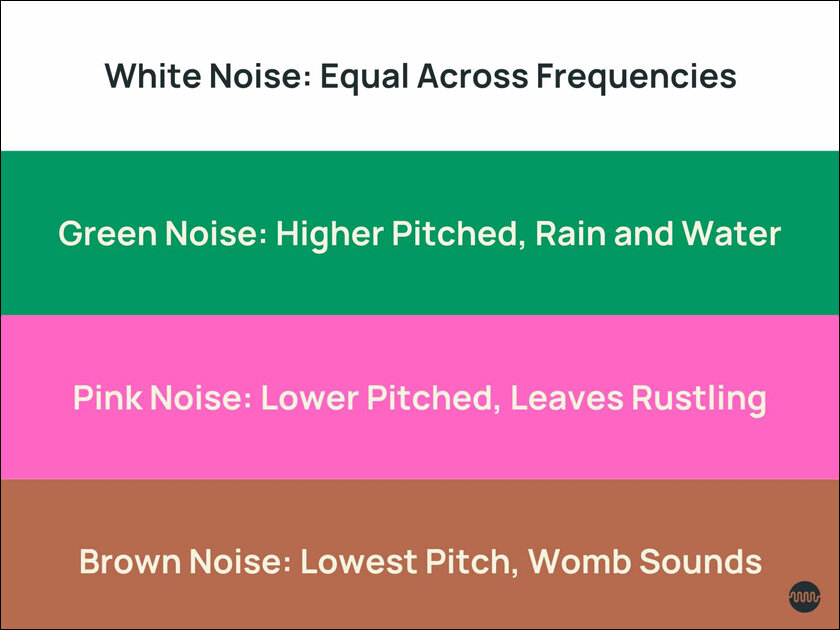Green noise differs from its counterparts like white and pink noise, offering a balanced frequency profile with a unique intensity distribution.
Green noise, also known as Emerald or Jade noise, is a term used in the field of sound and acoustics to describe a type of noise that has an equal amount of energy per octave. It is named “green” because, in the context of visible light, green represents the middle of the spectrum. Similarly, green noise is characterized by having equal energy across the entire audible frequency range, making it perceptually balanced.
The term “coloured noise” is often used to describe different types of random signals with varying energy distribution across frequencies. White noise, for example, has equal energy across all frequencies, while pink noise has equal energy per octave.

In the case of green noise, the intensity decreases by 3 decibels (dB) with each doubling of frequency. This gives it a unique spectral profile that some people find more natural, or soothing compared to other types of noise. Green noise is not as commonly encountered as white or pink noise, but it is used in certain applications, such as audio testing and in the generation of sounds for relaxation or masking purposes.
The term “green noise” alludes to the calming noises of nature, such as rains, leaves rustling, waves flowing in, and birds tweeting. Being in tune with nature has the power to naturally soothe you, reduce worry, and encourage relaxation and better sleep. People who are sleep deprived or who are yearning for restful sleep are increasingly choosing this low frequency sound over the hissing white noise sound. The quality of sleep may be improved, relaxation can be increased, and tension can be decreased by listening to music that mimics the sounds of nature. Additionally, green noise has been linked to increased awareness, sharper concentration, and less stress during the day.
By providing a consistent auditory environment, green noise can effectively buffer these disruptions and help you fall asleep or go back to sleep more quickly if you are awakened.
Green noise can help in enhancing sleep quality:
Green noise, like other types of coloured noise, can be used to enhance sleep quality in several ways:
1. Masking External Sounds:
Green noise, with its balanced frequency distribution, can help mask or block out external sounds that may disrupt sleep. This is particularly useful in urban environments or places with a high level of ambient noise.
2. Promoting Relaxation:
The balanced nature of green noise may contribute to a more relaxing and soothing auditory experience. This can help calm the mind and create a conducive environment for sleep.

3. Improving Concentration:
For some individuals, green noise can aid concentration and focus by providing a consistent background sound that drowns out distracting noises. This can be helpful for people who live in noisy areas or who have difficulty concentrating in silence.
4. Stress Reduction:
The calming effect of green noise may contribute to stress reduction, helping individuals unwind and relax before bedtime. Reduced stress levels can be beneficial for achieving better sleep.
5. Enhancing Sleep Onset:
Green noise, when used as part of a bedtime routine, can signal the brain that it’s time to wind down and prepare for sleep. Consistent use may condition the brain to associate the sound with sleep onset.
6. Improving Sleep Architecture:
Some studies suggest that exposure to certain types of noise, including green noise, can positively influence sleep architecture, leading to more stable sleep patterns and improved overall sleep quality.
7. Customizable Sound Environment:
Green noise can be adjusted in volume to suit individual preferences. This customization allows people to create a personalized sound environment that optimally supports their sleep needs.
8. Normalizes heart rate:
Prior to sleep, green noise has been demonstrated to regulate heart rate variability, preparing the body for sleep.
9. Enhances dream recall:
Better dream recall is facilitated by more stable sleep, and green noise helps to prevent mid-sleep awakenings.
It’s important to note that the effectiveness of green noise or any other sound for sleep can vary from person to person. While some individuals find it beneficial, others may prefer different types of sounds or complete silence. Experimenting with different sounds and observing personal responses can help individuals identify what works best for them in terms of promoting better sleep.
The more benefits of green noise for sleep and mental health:
In addition to the potential benefits mentioned earlier, green noise may offer further advantages for both sleep and mental health:
1. Reducing Anxiety:
The calming and consistent nature of green noise may help reduce anxiety levels. Anxiety can be a significant barrier to falling asleep, and a soothing sound environment might contribute to a sense of security and relaxation.
2. Enhancing Cognitive Function:
Sleep that is both peaceful and adequate is essential for brain health. Green noise’s ability to mask disruptive sounds and promote a relaxed state may contribute to improved cognitive performance and alertness during waking hours.
3. Improving Sleep Consistency:
Using green noise regularly as part of a sleep routine can help establish a consistent sleep environment. Consistency is important for regulating the body’s internal clock and promoting healthy sleep patterns.

4. Managing Tinnitus:
People experiencing tinnitus (ringing or buzzing in the ears) may find relief with green noise. The balanced frequency distribution can provide a gentle background sound that helps mask the perceived noise associated with tinnitus, allowing for better sleep.
5. Stimulating Relaxation Response:
Exposure to calming sounds like green noise may activate the parasympathetic nervous system, promoting the relaxation response. This can lead to lower heart rate, reduced muscle tension, and an overall sense of calmness, which is beneficial for both sleep and mental well-being.
6. Improving Mood:
Quality sleep is closely linked to mood regulation. By creating a more conducive sleep environment, green noise may contribute to a positive mood and emotional well-being.
7. Assisting with Sleep Disorders:
Green noise, used in conjunction with other therapeutic approaches, may be part of a comprehensive strategy for managing sleep disorders such as insomnia. It can be particularly helpful when addressing difficulties associated with falling asleep or staying asleep.
8. Enhancing Mindfulness and Meditation:
Green noise can serve as a background for mindfulness exercises or meditation. Its balanced and neutral qualities make it a versatile tool for individuals seeking a calm and focused mental state.
It’s essential to recognize that individual preferences and responses to sounds can vary. While green noise holds promise for many people, some individuals may find other types of sounds or relaxation techniques more effective for their sleep and mental health needs. Experimentation and personalization are key in finding the most beneficial approach.

How to benefit from green noise
There are various options available for incorporating green noise into your sleep routine to enhance its quality. Apart from using smartphone apps and online platforms offering a variety of soundscapes, including green noise, you can also opt for specialized white noise devices or sound generators designed specifically for producing green noise. Many of these devices allow you to customize settings such as volume to align with your preferences. Through experimentation with different soundscapes, including green noise and other options, you can identify the most suitable and effective auditory environment that meets your specific needs.
In conclusion, harnessing green noise can significantly contribute to improving sleep quality and overall well-being. Whether through smartphone apps, online resources, or specialized devices, the versatility of green noise allows for customization, catering to individual preferences. As explored, green noise differs from its counterparts like white and pink noise, offering a balanced frequency profile with a unique intensity distribution. The next article will delve deeper into the distinctions between various types of noise-white, pink, and brown, among others-exploring their applications and effects on sleep and mental health. Understanding these nuances can empower individuals to choose the most suitable soundscapes for optimal relaxation and restful sleep.










2 Comments
Very Nice Article !
Very useful